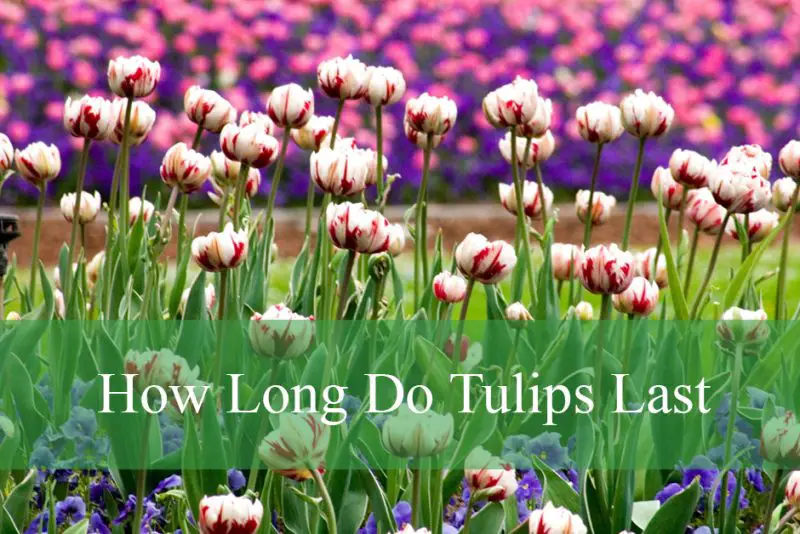Tulips are among the most iconic spring flowers, known for their vibrant colors and graceful shape. But as much as people adore them, a common question arises among gardeners and flower lovers alike: How long do tulips last after blooming?
This comprehensive guide explores the post-bloom lifespan of tulips in various settings and provides expert advice on extending their beauty.
Understanding the Tulip Lifecycle

Tulips may bloom for just a short period in spring, but their lifecycle spans several months, beginning long before any flowers are visible. From the moment a tulip bulb is placed in the ground, it begins a quiet but complex process that prepares it for that vivid display. Understanding this lifecycle provides deeper insight into the care and timing required to ensure strong blooms year after year.
Each phase of a tulip’s development plays an essential role in its overall health and ability to return in future seasons. While the colorful spring bloom is the most noticeable stage, much of a tulip’s life unfolds beneath the soil and beyond the bloom.
The Stages of Tulip Growth
Dormancy
Tulip bulbs are planted in the fall, typically between late September and early November, depending on the climate. Once underground, they enter a dormant state, essentially “sleeping” while the surrounding temperatures drop. This cold period is not only natural but necessary. The chilling effect of winter triggers biochemical changes inside the bulb, which prepares it for root and shoot development. Without this dormancy, tulips may fail to bloom or produce weak flowers.
Rooting
While tulips appear lifeless above ground during winter, they are far from inactive. As the soil cools, roots begin to form from the base of the bulb. This rooting stage is crucial, as the developing root system anchors the plant and begins to absorb nutrients and moisture from the soil. Healthy root growth during winter lays the foundation for robust spring performance, even though no leaves or flowers are yet visible.
Sprouting and Budding
With the arrival of early spring and rising soil temperatures, tulips break through the surface. Green shoots emerge first, followed by foliage and tightly wrapped buds. The plant channels energy upward, using the reserves stored in the bulb. This stage happens quickly, often over just a few weeks, and signals the imminent approach of blooming. The emerging leaves also serve to photosynthesize and further strengthen the bulb.
Blooming
Tulips typically bloom from early to mid-spring, depending on the variety and location. The flowers open gradually, revealing their iconic cup-shaped petals in a dazzling range of colors. While this is the most visually striking phase, it is also brief. Most tulip blooms last between one and two weeks. During this time, the plant focuses all its energy on reproduction—attracting pollinators and, in some varieties, forming seed pods if not deadheaded.
Post-Blooming
Once the petals fall, the tulip enters a critical but often overlooked stage. The green leaves remain photosynthetically active and continue to absorb sunlight. The energy collected is not for the current flower but is stored in the bulb to support next year’s growth. During this time, gardeners should avoid cutting back the leaves too early. Eventually, the foliage yellows and dies back naturally as the bulb re-enters dormancy. This cycle resets itself annually unless disrupted by disease, overcrowding, or poor conditions.
Factors Affecting Tulip Longevity
The longevity of tulips—both in bloom and as perennials—can vary widely depending on how they are cared for and the environment in which they grow. Though many gardeners treat tulips as annuals, especially in warmer climates, understanding the influencing factors can help prolong their beauty and encourage return blooms in subsequent years.
Climate and Temperature
Tulips are native to regions with cold winters and dry summers, which explains their need for a chilling period. In milder climates where winters are not sufficiently cold, tulips may not bloom reliably in future years. Some gardeners in these areas pre-chill bulbs in a refrigerator for 10–14 weeks before planting. Conversely, extremely harsh winters without snow cover can damage bulbs if not well-insulated.
Soil Quality
Well-drained soil is essential for tulip health. Bulbs that sit in soggy or heavy clay soils are prone to rot, which can prevent sprouting or flowering. A loamy or sandy soil with good drainage and moderate organic matter provides the best growing conditions. Nutrient availability also matters—adding compost or a balanced bulb fertilizer in fall can support healthy root and shoot development.
Watering Habits
Tulips require moisture after planting in fall and during active growth in spring, but excessive watering—especially during dormancy—can be harmful. Overwatering may cause bulb rot or fungal issues. Ideally, rainfall will suffice, but in dry climates or unusually dry seasons, supplemental watering should be done sparingly and with caution.
Type of Tulip Variety
Not all tulips are created equal in terms of longevity. Some varieties, such as Darwin Hybrids, are known for returning year after year and even naturalizing under ideal conditions. Others, especially the more ornamental or early-flowering types like Double Early or Parrot tulips, may be less perennial and often treated as annuals. Choosing long-lived varieties can improve your chances of enjoying tulips beyond a single spring.
Cutting or Deadheading Practices
How tulips are maintained after blooming also affects their return. Deadheading spent flowers prevents seed formation and allows the plant to focus on bulb nourishment instead. However, it’s crucial to leave the foliage intact until it naturally withers and yellows. Cutting back too soon interrupts energy transfer to the bulb, weakening next year’s growth. For cut flower arrangements, leaving enough foliage on the plant helps sustain its lifecycle.
How Long Do Tulips Last After Blooming in the Ground?
Tulips offer one of spring’s most breathtaking floral displays, but their beauty is fleeting. Once a tulip blooms, its vibrant petals typically remain fresh for only a short period. In garden beds and natural landscapes, most tulip flowers last between 7 and 14 days, depending on weather conditions and how well the plant is maintained. Cooler temperatures tend to prolong bloom time, while warm or windy days can accelerate petal drop.
While the flower itself is short-lived, the plant continues functioning well after the bloom has faded. Understanding what happens after flowering helps gardeners support the bulb’s ability to store energy and return the following year.
After the Bloom Fades
When tulips reach the end of their blooming phase, the petals often lose their vibrant color and texture. They may begin to curl, dry out, or fall off altogether, signaling that the flowering stage is complete. This withering process usually unfolds over several days. However, the tulip plant is far from done. The stem that supported the flower remains upright, and the green leaves stay attached, still serving a vital role in the plant’s lifecycle.
It is important during this stage not to remove the foliage prematurely. Though the tulip no longer looks as attractive, the leaves and stem continue to work behind the scenes, absorbing sunlight and creating energy. Removing them too soon can interrupt this process and reduce the bulb’s strength for the following season.
Lifespan of Foliage
After the petals have fallen, tulip foliage often remains green and upright for 4 to 6 weeks. During this time, the leaves are still photosynthesizing, converting sunlight into sugars that are stored in the bulb. This energy is critical—it helps the bulb survive the summer dormancy and prepare for growth in the next spring cycle.
Allowing the leaves to naturally yellow and wither is one of the best practices for tulip care. Once the foliage turns yellow and limp, it can be removed without harming the plant. Cutting back too early, however, can result in smaller or weaker blooms the following year—or no blooms at all. For this reason, patience during the post-bloom period is essential for gardeners hoping to enjoy tulips as reliable perennials.
How Long Do Tulips Last After Blooming in a Vase?
Tulips are among the most popular springtime cut flowers, known for their elegant shape and vibrant colors. While they bring seasonal beauty indoors, tulips tend to have a relatively short vase life compared to some other cut flowers. Once separated from their bulbs, tulips rely entirely on the care they receive in the vase to maintain freshness and color.
The vase life of tulips is influenced by several factors, including the freshness of the cut, water quality, temperature, and placement. With proper handling, their indoor display can be extended a few extra days beyond the average.
Vase Life Expectancy
Freshly cut tulips typically last between 5 and 7 days when placed in water. In ideal conditions, and with proper maintenance, some can remain attractive for up to 10 days. However, it’s normal for tulips to begin wilting or bending slightly by the end of the first week. Their stems continue to grow even after cutting, which sometimes causes the flowers to stretch or droop over time.
Unlike woody-stemmed flowers, tulips are particularly sensitive to environmental changes, and even a few hours without water can hasten their decline. For best results, they should be arranged in a vase as soon as possible after cutting.
Tips to Extend Vase Life
To enjoy tulips for as long as possible indoors, a few thoughtful care steps can significantly improve their longevity. Start by trimming the stems at a diagonal angle, which allows for greater water uptake. Using a sharp knife or floral shears helps avoid crushing the stem tissue.
Place the tulips in a clean vase filled with fresh, cold water. Change the water every other day to keep bacteria at bay and maintain hydration. Adding floral preservatives can help, or alternatively, a homemade mix of lemon juice and a teaspoon of sugar can provide nutrients while keeping the water slightly acidic to slow bacterial growth.
Finally, keep the vase in a cool location, away from direct sunlight, heating vents, and ripening fruit. Apples and other fruits emit ethylene gas, which accelerates flower aging and causes petals to fall prematurely. By following these practices, the graceful beauty of cut tulips can be enjoyed indoors for up to a full week or more.
How to Care for Tulips After They Bloom
Tulips may appear finished once their bright blossoms fade, but the care provided after blooming plays a vital role in ensuring strong and healthy growth in the following year. Whether grown in garden beds or containers, tulips require attention even after their flowers have wilted. This post-bloom period is when the plant begins to redirect energy back into the bulb, setting the foundation for future growth and flowering.
Understanding the proper steps to take during this time—such as deadheading, watering, fertilizing, and cutting back foliage—can dramatically improve the health and longevity of tulip bulbs in the years to come.
Deadheading Tulips
Deadheading is an essential task in post-bloom tulip care. This process involves removing the faded flower heads once the petals begin to wither. The goal is to prevent the plant from directing energy into producing seeds, which is a natural but energy-consuming process. Instead, this energy can be redirected into nourishing the bulb underground.
To deadhead tulips properly, use clean, sharp scissors or garden snips. Carefully snip off the flower head just below its base, making sure not to disturb the leaves or stem. The foliage should be left intact, as it continues to photosynthesize and store nutrients. Keeping the leaves untouched allows the plant to gather the energy it needs to prepare for dormancy and support future blooming.
Watering and Fertilizing Post-Bloom
Although the flowers are gone, tulips still benefit from consistent care in the weeks following blooming. Light watering should be continued, especially if the weather is dry. The soil should remain slightly moist but never soggy, as overwatering can lead to bulb rot. In well-drained beds or containers, a steady supply of moisture helps the plant continue photosynthesis through the remaining foliage.
Fertilization at this stage can also be beneficial. A balanced or low-nitrogen fertilizer, such as a bulb booster, can be applied to encourage the bulb to store essential nutrients. Avoid high-nitrogen formulas, as they promote leaf growth rather than root and bulb development. The best time to fertilize is right after blooming, while the leaves are still green and actively working.
Cutting Back Leaves
One of the most common mistakes in tulip care is removing the foliage too early. It may be tempting to tidy up the garden once the blooms are gone, but cutting back green leaves can significantly weaken the bulb. The leaves need time to yellow and wither naturally, a process that typically takes about four to six weeks after flowering.
Wait until the leaves have turned completely yellow or brown and have lost their structure before removing them. At this point, the foliage has completed its job of feeding the bulb, and cutting it away will no longer impact the plant’s health. This patience will pay off the following spring, when tulips return with renewed vigor and brighter blooms.
What Happens to the Bulb After Blooming?
While tulips put on their most visible show in spring, much of their important work begins after the petals fall. The flowering stage may be short-lived, but what follows is a critical phase in the tulip’s lifecycle: the bulb’s preparation for future growth. During this post-bloom period, the bulb transitions from supporting flower production to storing nutrients for the next season. How well this process goes directly impacts the plant’s ability to return with strong, healthy blooms the following year.
Understanding what happens to the tulip bulb after blooming helps gardeners provide the right care and make informed decisions about whether to leave the bulb in place or lift it for storage.
Storing Energy
After the flowers fade, the tulip bulb enters a vital rebuilding phase. The remaining green foliage continues to carry out photosynthesis, absorbing sunlight and converting it into sugars and starches. These nutrients are channeled back into the bulb beneath the soil, essentially “recharging” it for the next bloom cycle. In this way, the leaves act like solar panels, collecting energy that fuels the tulip’s dormancy and eventual reawakening.
This energy storage is especially important for tulips to function as true perennials. While some tulip varieties are more reliably perennial than others, all of them depend on a strong post-bloom period to store sufficient reserves. Cutting foliage too early or failing to provide adequate light and moisture can weaken this process, resulting in fewer or smaller blooms—or no flowers at all—during the next spring.
Dormancy Resumes
As the weeks pass and the foliage gradually yellows and dies back, the tulip bulb begins to slow its activity. By early summer, the plant enters dormancy, retreating into the soil in a state of rest. In colder climates, the bulb can often be left undisturbed in the ground to overwinter naturally. The chilling period that follows during fall and winter is necessary to trigger blooming again in the spring.
However, in warmer regions or areas with wet summers, gardeners may choose to dig up the bulbs and store them in a cool, dry place. This prevents rot and allows for better control over replanting. Whether kept in the ground or lifted, dormant tulip bulbs require little attention until the next planting season—but the quality of their rest depends on how well they were cared for during and just after the bloom.
Lifespan of Different Tulip Varieties After Blooming
Tulips may share a common name, but the characteristics and post-bloom longevity of each variety can vary widely. Some tulips are bred for early color and short displays, while others are prized for their strength, longer-lasting blooms, or suitability as perennials. Understanding the typical bloom period and lifespan of popular tulip varieties helps gardeners choose the best types for their climate and design goals.
Each variety brings something unique to the garden, and their differences in bloom time and durability can affect not only how long they last after blooming, but also how they perform in future seasons.
Darwin Hybrid Tulips
Darwin Hybrid tulips are among the most dependable and long-lasting tulip types. They typically bloom in mid to late spring and are celebrated for their tall, sturdy stems and large, vibrant flowers. Under favorable conditions, their blooms can last between 10 to 14 days, making them one of the longest-blooming types in the tulip world.
In addition to their visual appeal, Darwin Hybrids are valued for their perennial tendencies. With proper post-bloom care, including allowing foliage to fully wither and using appropriate fertilization, they can return year after year. Their resilience and ability to naturalize in some climates make them a favorite for gardeners looking for both beauty and longevity.
Single Early Tulips
Single Early tulips are known for their ability to bring some of the first spring color to the garden. These tulips bloom in early spring and are often shorter in stature, making them ideal for front borders and containers. Their flowers typically last around 7 to 10 days, depending on temperature and exposure.
While visually striking with their classic tulip shape, Single Early tulips may have a shorter post-bloom display compared to other types. Their compact form also means they may not last as long in vases or withstand warm temperatures as effectively. Nonetheless, they remain popular for gardeners seeking early-season blooms and clean lines.
Parrot Tulips
Parrot tulips are show-stoppers with their fringed, feathered petals and dramatic color blends. These eye-catching blooms appear in late spring and can last up to 10 days, although they are somewhat more delicate than sturdier varieties. Their ornate petals are more sensitive to heat and wind, often fading faster in hot or dry climates.
While they may not last as long as other types after blooming, Parrot tulips make a bold statement in the garden or as cut flowers. Their exotic appearance and unique petal shapes attract attention, though they are best used in protected garden spots or arrangements kept away from direct heat.
Triumph Tulips
Triumph tulips strike a balance between beauty and versatility. Blooming in mid-spring, they offer a bloom duration of approximately 8 to 12 days. These tulips are commonly seen in professional floral arrangements because of their uniformity, classic shape, and strong stems.
Though not as long-lasting in the ground as Darwin Hybrids, Triumph tulips hold up well when cut and arranged, making them a favorite for bouquets. They also perform well in pots and borders, offering solid mid-season color with a dependable bloom time under average conditions. With their wide range of colors and solid structure, Triumph tulips are a reliable choice for gardeners seeking both form and function.
How Climate Affects Tulip Lifespan
Tulips are remarkably sensitive to environmental conditions, and their lifespan—both during bloom and after—can vary significantly based on climate. Temperature and humidity influence how quickly tulips flower, how long the blooms last, and how efficiently the foliage can support the bulb after flowering. Understanding these climate effects can help gardeners adjust their care routines for optimal tulip health and longevity.
Whether in the ground or in containers, tulips will react differently in cool versus warm climates. Their bloom performance and the duration of post-bloom stages depend heavily on local growing conditions.
Cool Climates
In cooler regions, tulips tend to bloom more slowly, which often results in a longer-lasting floral display. The gradual warming of spring allows the blooms to open at a steady pace, sometimes extending their presence in the garden to two full weeks or more. In these environments, the lower temperatures help preserve petal integrity, reducing the chance of early wilting or petal drop.
After blooming, tulip foliage also tends to remain green and photosynthetically active for a longer period. This extended post-bloom phase gives the bulb ample time to absorb energy and store nutrients for the next season. Gardeners in cooler zones often find their tulips return reliably year after year, especially with proper care and soil conditions that prevent excessive moisture retention.
Warm Climates
In warmer zones, tulips typically bloom and fade much faster. High temperatures can cause the flowers to open quickly, often shortening their peak appearance to less than a week. Additionally, the heat can lead to premature petal drop or fading, especially in more delicate varieties like Parrot tulips. The window for enjoying blooms is much narrower, making precise timing critical for display planning.
Foliage in warm climates also deteriorates more rapidly. The heat accelerates the breakdown of chlorophyll, leading leaves to yellow sooner and reducing the time available for nutrient storage in the bulb. Gardeners in these regions need to be especially mindful of watering, mulching, and possibly providing partial shade to extend both bloom and post-bloom phases. In some hot areas, tulips may not perennialize well without artificial chilling of the bulbs before planting.
Do Tulips Come Back Every Year After Blooming?
Many gardeners wonder if tulips reliably return each spring after blooming or if they need to replant bulbs annually. While tulips are technically classified as perennials, their ability to come back year after year depends on a variety of factors including the variety, climate, soil conditions, and care practices. Understanding these influences can help gardeners set realistic expectations and make the best choices for their garden.
Naturalizing Tulips
Certain types of tulips, particularly species tulips and Darwin hybrids, have a strong tendency to naturalize. Naturalizing means the bulbs multiply and reappear in the garden over multiple seasons with minimal intervention. These tulips adapt well to the local climate and soil, allowing them to thrive and bloom repeatedly.
Species tulips are closer to wild varieties, often smaller but very hardy and reliable perennials. Darwin hybrids combine strong growth habits with long-lasting flowers, making them favorites for gardeners hoping to enjoy tulips year after year. When planted in well-drained soil and given proper post-bloom care—especially allowing the foliage to die back naturally—these tulips can become dependable, self-sustaining garden fixtures.
Annual-Like Behavior
In contrast, many popular tulip varieties behave more like annuals in certain climates or soil types. Warmer regions, heavy clay soils, or overly wet conditions can cause bulbs to weaken, rot, or fail to store enough energy for the following season. As a result, these tulips may not reliably bloom again, prompting gardeners to treat them as annual plants.
For gardeners wanting consistent spring displays, replanting tulip bulbs every year is often the most practical approach. This ensures vibrant, fresh blooms but requires yearly investment and effort. Understanding the specific tulip variety’s hardiness and the local growing conditions can guide whether to expect naturalized blooms or plan for annual replanting.
How to Store Tulip Bulbs After Blooming
For gardeners who choose to dig up their tulip bulbs rather than leave them in the ground, proper storage after the growing season is crucial to ensure healthy blooms the following year. Tulip bulbs need to be carefully handled and stored in ideal conditions to prevent rot, mold, or premature sprouting.
Digging Up the Bulbs
It is important to wait until the tulip foliage has completely died back before digging up the bulbs. The yellowing and withering of the leaves indicate that the bulb has finished storing nutrients for the next growth cycle. Using a garden fork or a similar tool, gently lift the bulbs from the soil, taking care not to damage them. Avoid pulling the bulbs out by hand as this can bruise or break the bulb’s outer layers.
Once lifted, gently brush off any excess soil from the bulbs. It is best not to wash them with water because moisture can promote fungal growth and rot during storage. Removing loose dirt is enough to keep the bulbs clean without adding unnecessary dampness.
Storing Bulbs
After cleaning, bulbs should be stored in a dry, cool, and well-ventilated area. Ideal storage temperatures typically range between 50 to 60 degrees Fahrenheit (10 to 15 degrees Celsius). This environment mimics the natural cool and dry conditions tulip bulbs require during dormancy.
Placing the bulbs in breathable containers such as paper bags, mesh baskets, or cardboard boxes allows air circulation and reduces the risk of mold or mildew. It’s essential to avoid plastic bags or airtight containers, which trap moisture and can cause bulbs to rot. High humidity environments should also be avoided, as dampness is a major factor in bulb decay. Properly stored tulip bulbs can remain viable for several months until it’s time to replant them in the fall.
Common Mistakes That Shorten Tulip Lifespan
Tulips are relatively easy to grow, but certain mistakes can affect their longevity after blooming.
Cutting Foliage Too Early
Removing leaves too soon cuts off the energy supply to the bulb.
Overwatering After Bloom
Tulips dislike soggy conditions. Too much water post-bloom can lead to bulb rot.
Leaving Diseased Plants in the Ground
Diseases like Botrytis tulipae can spread to healthy bulbs. Always remove and destroy infected plants.
Companion Plants for Extended Garden Beauty
Since tulips have a relatively short bloom time, combining them with other flowers can help keep your garden vibrant.
Good Companions
- Daffodils: Bloom at similar times but last longer.
- Hyacinths: Add fragrance and color.
- Hostas: Fill in empty space once tulip foliage dies back.
Conclusion: Making the Most of Your Tulips
So, how long do tulips last after blooming? In the ground, tulip blooms last around 1–2 weeks, and the foliage remains for several weeks longer. In vases, cut tulips last about 5–7 days. But with the right care—deadheading, delaying foliage removal, and proper watering—you can ensure your tulips thrive year after year.
Tulips may be fleeting in bloom, but their charm, color, and elegance leave a lasting impression. Understanding their lifecycle and post-bloom needs will help you enjoy healthier plants and a more beautiful garden season after season.






